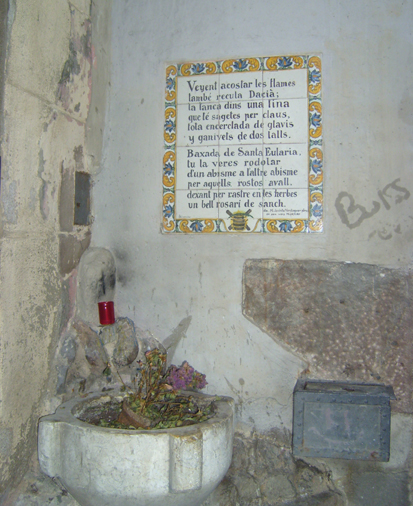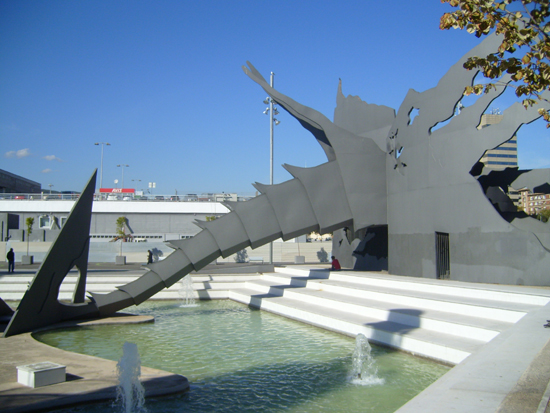The saints and souls of Barcelona
October has turned out to be an oddly morbid month. Maybe the Devil really did unleash the spirits when Hell’s Gate hiccupped at the end of September, because my autumn so far has been strangely peopled with scenes of saints, souls and compulsions to wander through Barcelonan cemeteries.
Plus the hamster died.
So, as tomorrow is All Souls’ Day and Tuesday All Saints’ Day, I thought I’d follow the breadcrumbs and try and improve my knowledge of Catalan history a bit at the same time.
Some hairy hagiography
Even for a Catholic, Spanish city, Barcelona packs a pretty punchy pantheon. I mean, there are vestiges of saints’ lives everywhere. They’re just much more present than I ever remember them elsewhere – in Scotland or even in Madrid. Most prolific of all is the co-patron saint of the city, the ill-fated Santa Eulàlia.
By all accounts, Laia was a real person – a local girl born around three centuries after Jesus, who was tortured to death by the Romans when she was only 13 for refusing to recant her beliefs in Christianity. Barcelona’s Cathedral was erected in her honour, the schooner anchored in the old port is named after her and there’s even a metro station bearing her name. Not to mention the alleyway in the Gothic quarter, ‘La Baixada de Santa Eulàlia’, where she’s said to have suffered her greatest torments.
So who was this young upstart whose name inspires the building of cathedrals, ships and metro stations?
Well, folks, the first thing official records will have you know is that she was a virgin martyr. This seems a) axiomatic, given her age, and b) irrelevant, given what we know nowadays about sexual experience being of negligible influence when it comes to one’s success as an intercessor to the gods. Or maybe that’s just me.
But what most people associate with Eulàlia is the series of increasingly brutal tortures that Diocletian, the then Roman Emperor, decreed she should suffer. (When it came to devising sadistic tortures, this guy had form.) It’s said she underwent 13 tortures, one for each year of her life. These included having her breasts cut off, being rolled down a slope inside a barrel of knives, being crucified on an X-shaped cross (she’s often depicted with this) and finally decapitation. (I imagine this was a relief, by that point.) Her remains are buried inside a crypt within the Cathedral, where she’s also honoured in ornithological fashion, in the form of the 13 geese who inhabit the cloisters. Legend has it that a dove flew out of her neck when she was finally decapitated, so there’s a link with white birds in there somewhere.
It’s my party and I’ll cry if I want to
Eulàlia was the original patron saint of Barcelona, but she found herself having to share the limelight towards the late 17th century with La Mercè. (Our Lady of Mercy. That’s right. Another virgin.) This one’s story is a lot more sketchy, in my opinion. She was officially proclaimed patron saint of the city after supposedly delivering it from a plague of locusts. Even the Pope was reluctant to endorse Eulàlia’s relegation, and didn’t ratify La Mercè’s promotion until the end of the 19th century.
Whereas Eulàlia’s feast day in February passes by without ceremony, La Mercè’s festival, as you can see from my last post, is a riot of fire-runs, giants and minor demons. The 4-day event at the end of September should be blessed with good weather, given that temperatures in the high 20s are not uncommon throughout October, but traditionally, it rains heavily for at least one day. According to legend these are the tears of Eulàlia herself, piqued at the pinching of her patronage. Fair enough, if you ask me. Locusts, indeed.
So what of the men?
Maybe it’s the human hankering for a goddess to worship, but Sant Jordi (Saint George), the patron saint of Cataluña as a whole, barely gets a look-in around here. His absence is nowhere better symbolised than in the cast-iron sculpture of a woebegone dragon in the Parc de l’Espanya Industrial, entitled ‘The Dragon without Saint George’. Even in his moment of glory, he manages to miss it. His feast day is the 23rd of April, where in Cataluña he represents a sort of pallid version of St Valentine. Women gift books to their menfolk (“because they last forever”) and in turn receive roses.
This Sant Jordi, in case you were wondering, is the same Saint George that the English, and a whole host of other countries, hold in such esteem. An interesting parallel exists with the life of Saint Eulàlia. George was a military man, who presented himself to Diocletian (remember him?) in search of a career as a soldier. Very close to the time that Eulàlia was being murdered, Diocletian issued an edict that all Christian soldiers should be forced to convert or face death. George, like Eulàlia, refused to recant, and was tortured and martyred as a result.
However, as I know you’re clamouring to find out, historical accounts fail to note whether he was a virgin. The dragon had some tales to tell, but these remain unsubstantiated.



 Guiri is one of those words, like feminist or peely-wally, that I want to reclaim. Locals use it to refer to tourists - you know the ones - who stick out a million miles. No matter how long I live in Barcelona, that's always going to be me. (P.S. While Barça locally refers to the football team, Brits use Barca as shorthand for the whole city.)
Guiri is one of those words, like feminist or peely-wally, that I want to reclaim. Locals use it to refer to tourists - you know the ones - who stick out a million miles. No matter how long I live in Barcelona, that's always going to be me. (P.S. While Barça locally refers to the football team, Brits use Barca as shorthand for the whole city.) 







Thank you for your post, really interesting! I was really curious to know who is the patron saint of Barcelona, and thanks to you, I have found out! Keep up the good work!